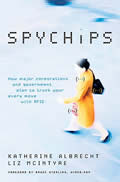Other
Ryter
Articles:
The Two Kerry's:
War Hero or
Traitor?
"Men in Black" The Cult of The Judges
WHEN
PREDATORS BECOME VICTIMS
PART 1 of 2
By Jon Christian Ryter
December 6, 2005
NewsWithViews.com
The 1,000th prison inmate to be put to death since the US Supreme Court's 10 year moratorium on executions was Kenneth Lee Boyd, a 57-year old double-murderer. Boyd was executed at 2 a.m. on Dec. 2, 2005 in North Carolina's Central Prison. Interviewed by the media on Thursday, Boyd said he did not want to be remembered by that benchmark�the 1,000th inmate executed.
He doesn't have too much to worry about. A week from now nobody will even remember his name. They may remember the crime. Boyd, a man with a serious drinking problem, was estranged from his wife. She left him because of his love affair with the bottle. He thought she had a boyfriend. In a drunken jealous rage, he broke into his in-laws home in 1988 and, in what was likely argued by his lawyer as a crime of passion, he shot and killed his wife and then, his father-in-law. Aside from the fact that double murderers are generally charged with capital murder, Boyd's crime was particularly heinous since his wife, realizing her estranged husband planned to gun down her whole family, threw her arms around one of her two small sons, protecting his body with hers as she fell to the floor. Boyd stood over her and emptied his gun into her in an attempt, the prosecution argued, to kill his son who was protected by her bloody, bullet-riddled body. I suspect if Boyd is remembered for anything, it will be for this. I know he won't be missed.
The biggest tragedy in the execution of Kenneth Lee Boyd�bigger even than the fact that his two sons were forced to endure the murder of their mother and grandfather�is that it took 17-years for the State of North Carolina to carry out the sentence. Sadly, Boyd's wife didn't get to live an additional 17-years when he sentenced her to death. Neither did her father. His lawyer, in a last ditch appeal to the US Supreme Court, argued that before he committed his double murder, Boyd held down a steady job and had no record of violent behavior. I'm amazed how many "model citizens" are incarcerated on death row in America's prisons. I supposed the fact that he didn't have a violent past somehow made his crime less violent, and mitigated the pain his wife and father-in-law suffered when he callously snuffed out their lives.
The debate on execution in America ratchets up whenever a spate of executions occur or when a "popular" killer like Stanley "Tookie" Williams is only days from visiting the gurney in the execution chamber as the advocacy of anti-death penalty groups in America increase. The debate on the death penalty is now at a crossroads for several reasons.
First, the debate is once again centered on whether or not the death penalty is a deterrent to murder. Second, by February, 2005, 120 inmates on death rows around the country have been exonerated�one, posthumously. That man was Larry Griffin, who was wrongly convicted of killing a drug dealer named Quinton Moss in St. Louis on June 26, 1980. Even though the evidence against him was a sham in which the State's star "eye" witness (who traded his testimony for a free pass from jail) was not even at the scene of the crime. Of course, neither was Griffin. Griffin was in another part of the city helping a friend sell a boat. Unfortunately for Griffin, while all of the parties remember the transaction occurring on June 26, the buyer of the boat dated his check for the 27th, and the prosecution argued that the boat sale was a day after the killing. Griffin was convicted with perjured testimony and executed for a crime he did not commit. Because St. Louis detectives had a "gut instinct" that Griffin was the killer (since Moss killed his brother), their investigation consisted only of making sure the evidence fit the the man they believed was guilty. Because of that, several eyewitnesses that were there and saw Moss gunned down, were never interviewed by St. Louis police.
And finally, the Washington Post, New York Times and several other large metro newspapers have reported that serious problems have been uncovered in the FBI's DNA laboratory, with the Justice Department admitting that the results from several hundred DNA tests in rape and murder cases conducted by the FBI are probably wrong. In their "zeal" to help local prosecutors convict those who the local police say are the bad guys, the FBI's forensics people have not been quite as diligent as they should have been in matching genetic codes. "Close" works in horseshoes, but not in DNA�particularly when lives depend on the accuracy of that analysis.
Ask Robin Lovitt. Lovitt was convicted of the 1999 stabbing death of Clayton Dicks, the night manager of a Virginia pool hall. From the moment he was arrested, Lovitt maintained his innocence. The crime was committed with a pair of scissors. Police found blood on the scissors and�they said�on Lovitt's jacket. The evidence was sent to the FBI who said it was a match. After a speedy trial, Lovitt was convicted and sentenced to death.
During the trial the prosecutor argued that DNA evidence showed that Lovitt handled the murder weapon, and that Dicks' blood on Lovitt's jacket proved he was the killer. The jury bought the argument. After all, DNA is never wrong. It's the genetic blueprint of the person. But, DNA is correct only when the forensic scientists who read the code are diligent in matching the genetic strands found on the suspect with the DNA of the suspect. In Lovitt's case, the test results were inconclusive. They simply did not support the argument of the prosecution�and the prosecution knew it. But, once again, the local police were convinced they got the right man and everyone in the criminal justice system did what they could to oblige them.
When a petition for clemency for Lovitt were sent to the office of Democratic governor Mark Warner. The governor wanted to review the DNA evidence in the Lovitt case, only to discover that the trial judge ordered all of �including the murder weapon and Lovitt's jacket�destroyed. Defending the magistrate, the senior court clerk who prepared the order under the judge's name said he, not the judge, ordered the evidence destroyed. He did it, he said, believing, that it was no longer needed since the case was over.
In defending the actions of the senior clerk, the newly elected Attorney General of Virginia attempted to diminish the value of the DNA evidence by suggesting that Lovitt's conviction came from eye witness testimony and not from questionable DNA evidence. The eye witness, however, was a man who admitted under oath prior to the trial that he couldn't see the assailant's face. When he was asked to identify the killer during the preliminary hearing, the witness admitted he couldn't be sure it was Lovitt because the crime happened "...a long time ago and he saw the [killer] only for a couple of seconds." At trial, the same witness was "...80% sure" because, he said, "...everytime I see him, he looks more like the person I saw." Lovitt was actually fingered by a jailhouse snitch with an axe to grind who was looking for privileges in exchange for his testimony against Lovitt. The odds are very good that Lovitt is an innocent man whose death sentence was just commuted to life in prison without a chance for parole. Unlike Larry Griffin, Lovitt will still be alive when some honest prosecutor exonerates him.
While Griffin and Lovitt offer excellent arguments for abolishing the death penalty, Tookie Williams, Eric Nance, John Hicks and Joseph Smith are prime examples of why the death penalty exists, why it is needed, and why it should be used without interference from social justice advocates.
Jurors in the murder trial of Joseph Smith�who raped and murdered 11-year old Carlie Brucia in Sarasota, Florida after security cameras at a car wash captured the 39-year old mechanic as he kidnapped the girl on Feb. 1, 2004�had all the "eye-witness" evidence they needed to find the defendant guilty . The video, if you recall, was broadcast worldwide. There was no place Smith could hide. He was quickly identified and apprehended. After finding Smith guilty of kidnapping, first degree murder and sexual battery on a child, the jury deliberated a second time, on Dec. 1, 2005 for five hours and, by a vote of 10 to 2, recommended the death penalty.
Smith's attorney, Adam Tebrugge, argued that Smith was high on either heroin or cocaine when he ran into Brucia taking a shortcut through the parking lot behind the car wash. In the penalty phase, Tebrugge argued that Smith should be given a life sentence without parole. That would be, he said, "...a fitting conclusion to this horrific case. The Joe Smith on Feb. 1, 2004 was a man in pain, ravaged by drug abuse and out of control. The Joe Smith�the drug addict�who was out of control will never exist again because he will be kept away from drugs." A fitting end for Smith would be a swift and painful execution. Neither will happen. By the time Smith has exhausted all of his appeals, and by the time the anti-death penalty advocates delay the process, no one but her family will remember Carlie Brucia. His lawyers, a couple of decades later, will argue that the 60-year old Smith no longer poses a threat to society. Only her mother will grieve over the miscarriage of justice as the societal do-gooders paint the names of wrongly-executed inmates on placards as if to suggest that, just possibly, Smith did not get a fair trial.
At the conclusion of the penalty phase of Smith's trial, Brucia's mother, Susan Schorpen, summed it for every mother who was ever haunted by the memory of a violated, murdered daughter: "He may be condemned, but he's still breathing and my daughter is not." Justice for the Schorpen family will not come until Smith stops breathing. Smith did not hesitate a moment in taking Carlie Brucia's life. Why should her mother have to wait one or two decades for Smith to stop breathing? Where is her justice?
This is part of the reason that the death penalty is not the deterrent to murder that it should be. Anyone weighing the consequences of premeditated murder knows the odds of his or her ever being executed are fairly remote�assuming, first, that they are caught. It generally takes up to 20 years to execute a condemned prisoner. If the family members of the victim die before the killer, the odds for clemency increase exponentially.
Those convicted of capital offenses know that even if they are convicted, the odds are 50/50 that they will be sentenced to die. Once they arrive on death row, the odds of the execution actually being carried out are less than 50%�which suggests that only about 25% of who are convicted of first degree murder will be executed for their crime. A large percentage of those who are executed live a normal lifespan before the execution is carried out. If anyone suggests to you that a lifetime behind bars is worse than being executed, they're blowing smoke at you. If they were condemned to death and were about to be executed, I assure you that if they could exchange their death sentence for life behind bars, every one of them�without exception�would do it in a heartbreat...something their victims no longer possess. That's why commuting the death sentence of Crips gang founder Stanley "Tookie" Williams won't exact the penalty for the four lives snuffed out by Williams during two robberies in February and March, 1979 that the people of Los Angeles county demanded at his trial.
In 1971, a 17-year old Williams and his friend Raymond Washington, founded what became known the Crips in Los Angeles. In the ensuing decade, the Crips became LA's deadliest street gang and its biggest distributor of cocaine and heroin. It didn't take long before imitators sprang up all over the country, emulating the As he attempted to sanitize his image by changing the motives for his past, Williams recalled that he and Washington were fed up with all the random violence in South Central LA and decided to do something about it. What they decided to do, Williams said, was to "...cleanse the neighborhood of all these�you know�marauding gangs. Eventually," he concluded, "we morphed into the monster we were addressing."
On February 27, 1979 Williams ordered two of his gang members (identified only as Darryl and Sims) to rob a Stop-N-Go Market just off the freeway in Pomona, California. The pair entered the store armed with a .22 handgun. As Darryl approached the store clerk for cigarettes, Sims proceeded to the back of the store to check if any other employees on duty. Hearing someone else in the back, Sims turned and left the store. Darryl followed him.
Williams became angry because they failed to rob the store. He told them he'd find another place to rob. All of them would go, Williams said, so he could show them how it was done. In a stroke of bad luck for 7-Eleven manager Albert Owens at 10437 Whittier Boulevard in Pico Rivera, Williams chose him. As Darryl and Sims entered the 7-Eleven, Owens placed his broom and dustpan on the hood of his own car and followed them into the store. Williams and Alfred Coward, the 4th gang member, followed Owens. Once inside the store, Williams pulled a sawed-off shotgun from under his coat. He pressed it into Owens back and told him to "...shut up and keep on walking." Once in the backroom, Williams fired twice at close range, killing Owens. The robbery netted Williams $120.00 in cash.
Back in the car Sims asked Williams why he killed Owens. "Because he was white," Williams said, adding that he was going to kill all white people. Then he said he just didn't want to leave any witnesses behind. "You should have heard the way he sounded when I shot him," Williams laughed, making a gurgling sound.
|
Subscribe to the NewsWithViews Daily News Alerts! |
The second robbery for which Williams was convicted took place at the Brookhaven Motel in South Central LA. Court transcripts indicate that Williams entered the motel on South Vermont Avenue around 5 a.m. He walked directly to private office in rear of the lobby area and kicked in the door, startling the owner, Yen-l Lang, his wife Tsai-Shai Yang and their daughter, Yee-Chen Lin. The two women screamed. Without any provocation, Williams opened fire, killing all three members of the Yang family. When the autopsy was done on Yen-l Yang, the plastic container from the shotgun shell was recovered near his liver. The pathologist noted during the trial that the anomoly happened because the shotgun was held close to the victim when he was shot. Williams then shot Yee-Chen Lin in the face. Williams rammed the barrel of the shotgun into the buttocks of Tsai-Shai Yang�after his first shot hit her in the abdomen�as she struggled to turn to flee. He fired again. Both the wadding from the shotgun shell and the plastic shot container were recovered from Tsai-Shai's body. The second shot shattered her coccyx (tail bone). This crime was particularly heinous because of the coldbloodedness of the killings.
Click here for part -----> 2
� 2005 Jon C. Ryter - All Rights
Reserved
Order Jon Ryter's book "Whatever Happened to America?"
Sign Up For Free E-Mail Alerts
E-Mails
are used strictly for NWVs alerts, not for sale
Jon Christian Ryter is the pseudonym of a former newspaper reporter with the Parkersburg, WV Sentinel. He authored a syndicated newspaper column, Answers From The Bible, from the mid-1970s until 1985. Answers From The Bible was read weekly in many suburban markets in the United States.
Today, Jon is an advertising executive with the Washington Times. His website, www.jonchristianryter.com has helped him establish a network of mid-to senior-level Washington insiders who now provide him with a steady stream of material for use both in his books and in the investigative reports that are found on his website.
E-Mail: BAFFauthor@aol.com
Back in the car Sims asked Williams why he killed Owens. "Because he was white," Williams said, adding that he was going to kill all white people. Then he said he just didn't want to leave any witnesses behind.












